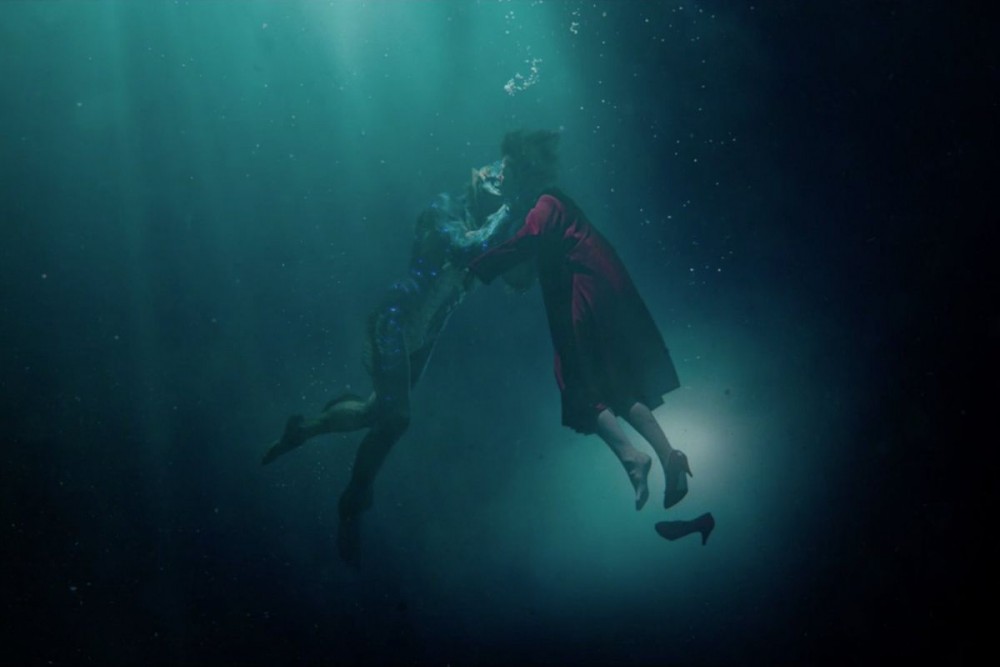It’s the age of time capsules and the Space Race, of turquoise Cadillacs and Jell-O pie. It’s the Cold War in the ’60s, and paranoia governs the States.
War sets the stage for many of del Toro’s narratives, and “The Shape of Water” is no exception. Wartime gives his films a mood of menace, one in which monsters make sense. Here, though, there is one important shift. The war is cold, and a threatening atmosphere hangs on locker room posters over everyone’s heads: “Loose lips might sink ships.”
Why did he choose to set this film during a war in which earth went un-scorched and blood went un-shed?
A&E was curious, so we asked him.
“I think that movies that happen anywhere matter nowhere, and movies that happen anytime matter at no time,” said del Toro. “You need to, as a storyteller, choose the place they take place in and the time they take place very, very, very carefully and very specifically. And ’62 for me is of course the Cold War, the Space Race… but it’s the last fairytale time in America, a time in which America kind of dreams itself into what we conceive as the modern America.
“[During the Cold War] the media is shaping the consciousness and the identity of the country. You have a candidate in the White House with damage yet to escalate, and you have suburban wealth everywhere: cars in every garage, TV, self-cleaning kitchen, petticoats and hairspray. It was really a time of great hope for the future. In fact, the country becomes obsessed with the idea of the future. I thought that and the Cold War were perfect settings to bring a creature from the ancient past and a love story in a time of difficult communication.
“Also, the movie is a movie about our problems today and about demonizing the other and about fearing or hating the other, and how that is a much more destructive position than learning to love and understand. I thought, ‘Well, if I do it about today it becomes too topical about the news. We get it in the news and social media and blah, blah, blah.’ But if I say once upon a time in 1962, it becomes a fairy tale for troubled times. People can lower their guard a little bit more and listen to the story and listen to the characters and talk about the issues, rather than the circumstances of the issues.”
“The Shape of Water” carries notes of Wes Anderson and slides comfortably into Jean-Pierre Jeunet territory — remember “Amélie”? — adhering to the red-green color scheme down to the Jell-O pie.
Film noir, ’60s household labor and advertisements transitioning to photography all create a setting that both welcomes and repulses you.
The thematic ties to “Pan’s Labyrinth,” his most notable movie to date, are strong: a curious, childlike protagonist, overlooked by those around her builds relationship with monster underground, meanwhile the egos of militant authorities wreak havoc on the lives of common citizens. As Elisa’s friend Zelda (Octavia Spencer) says, “Just how big or tall do they need to feel?”
But that’s true for most of del Toro’s films. He focuses on characters that go unnoticed because they appear meek, but who are as far from helpless as any soldier.
The actors play the characters vividly: Sally Hawkins startles and charms as the mute Elisa, and Michael Shannon will make your skin crawl like you were dropped in a cesspool filled with algae.
“The Shape of Water” has tenderness uncommon to del Toro films. Usually in his work, the darkness absorbs us; the monsters are physical evidence that worldly evil dwells nearby. Here, the Creature from the Black Lagoon has a heart, and it opens quickly for Elisa. This deters from the eerie mystery his on-screen creatures usually create, because we communicate with the monster through Elisa.
Even in sentimentality, however, del Toro keeps hold of the reins. He uses quaint nostalgia without laying it on too thick. The film pulls you into its black-water world while the quiet main characters leave you speechless for a moment.
It’s an old story with a creative spin. While “The Shape of Water” isn’t groundbreaking, it is elegant and mesmerizing.
Grade: A

















